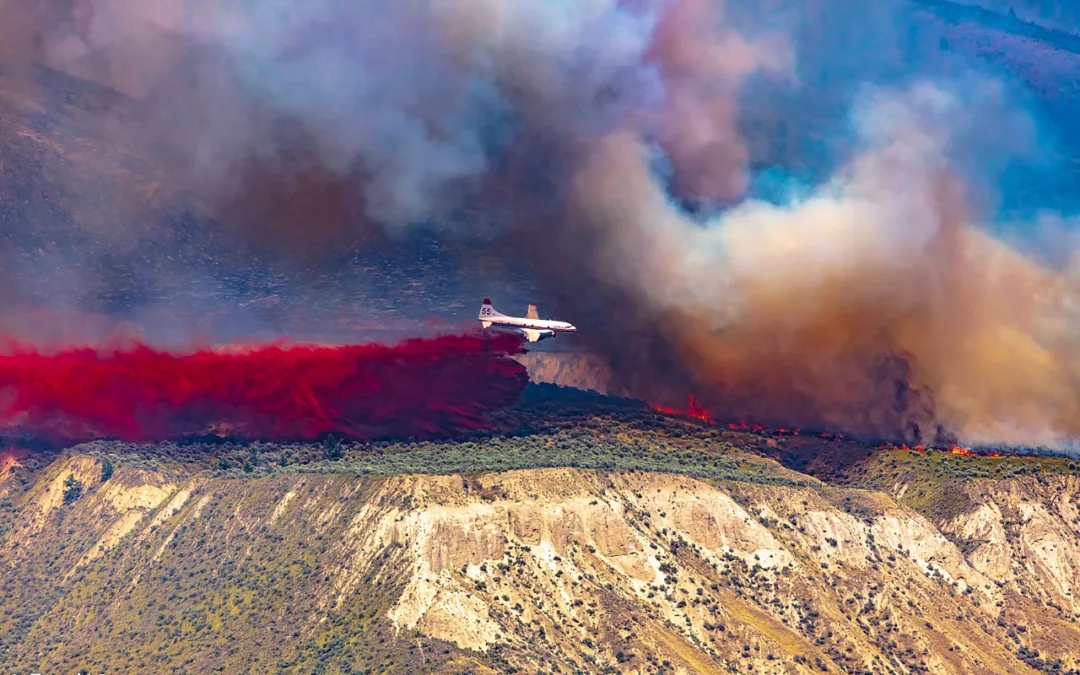
SkyScout AI offers new solution for wildfire detection, mitigation
We did a quick check, just now, on the current wildfire situation in British Columbia.
Nine wildfires were burning and labelled as “Out of Control” by the BC Wildfire Service. An additional two fires were categorised as “Wildfires of Note.” And we’re still very early in the wildfire season.
Recent years have seen an increase in devastating wildfires – in British Columbia, Alberta, California, Hawaii and elsewhere in North America. A 2014 fire in the Northwest Territories completely destroyed 8.5 million acres (3.44M hectares). There have also been massive wildfires in Portugal, Australia (42 million acres/17M hectares burned in 2019/2020), Russia – and other countries as well.
These examples are indicative of a trend; there’s compelling (and troubling) data to back this up.
“Multiple studies have found that climate change has already led to an increase in wildfire season length, wildfire frequency, and burned area,” says the United States Environmental Protection Agency. “The wildfire season has lengthened in many areas due to factors including warmer springs, longer summer dry seasons, and drier soils and vegetation.”
What’s worse is that major wildfires actually contribute to the likelihood there will be more of them in the future.
“Climate change is one of the major drivers of increasing fire activity,” says the World Resources Institute, which states that “the latest data on forest fires confirms what we’ve long feared: Forest fires are becoming more widespread, burning nearly twice as much tree cover today as they did 20 years ago…
“Extreme heat waves are already 5 times more likely today than they were 150 years ago and are expected to become even more frequent as the planet continues to warm. Hotter temperatures dry out the landscape and help create the perfect environment for larger, more frequent forest fires. This in turn leads to higher emissions from forest fires, further exacerbating climate change and contributing to more fires as part of a “fire-climate feedback loop.”
This is, obviously, concerning. Existing firefighting and fire suppression techniques haven’t changed much over the years – and the threat is growing.
A new Canadian company, SkyScout AI, believes it holds part of the solution. And after seeing a demonstration of some of its capabilities recently in British Columbia, we’re inclined to agree.
Below: SkyScout Ai’s Shawn Bethel prepares a “drone tanker” at a demonstration outside Penticton. Scott Simmie photo
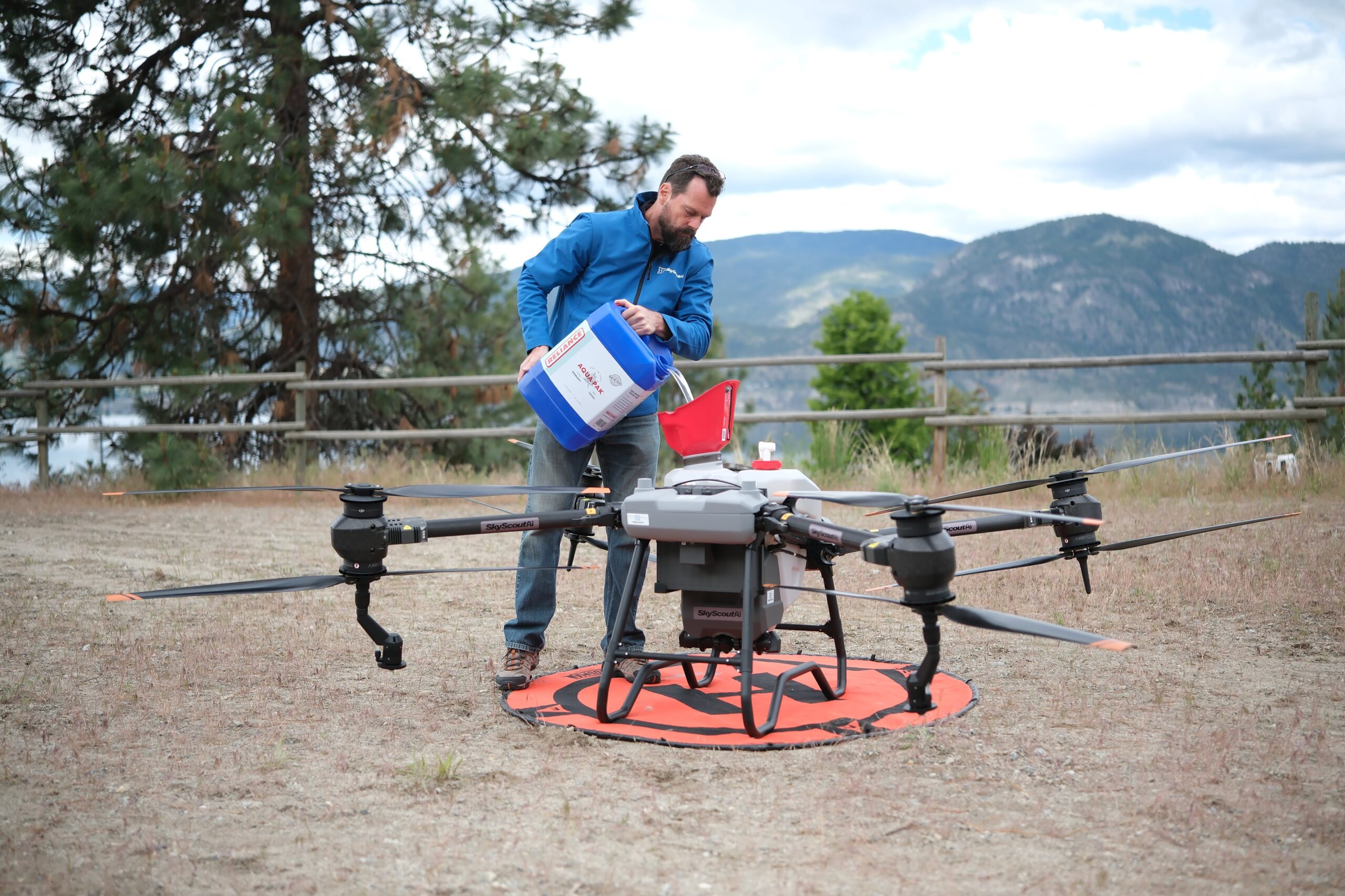
SKYSCOUT AI
So. What is SkyScout Ai – and what does its solution entail?
It starts with the leadership.
“It’s a company that’s comprised of people who want to make a difference for their communities and trying to save them as climate change drives increase in fire activity,” says Chief Operations Officer and Co-Founder Geoff Griffiths.
We’ll explore some of that shortly. First, though, we asked Griffiths for his elevator pitch.
“We’ve come up with a first-in-class vertically integrated solution that spans satellite and drone early detection. And we have the capability with our drone tanker to not only fight the fire but protect the communities from fire by pre-treating vegetation and housing with our EPA-certified fire inhibitor called Citrotech. So it really is about a fully vertically integrated approach that really focuses on interface fires – those fires that interface with communities and critical infrastructure, that’s really our niche.”
All you have to do is think back to Kelowna last year and the threat posed to the city by wildfires. The McDougall Creek Fire forced the evacuation of West Kelowna and made headlines across the country. Griffiths has seen such fires hit close to home.
“My parents were living in Kelowna during a major wildfire in 2003. Their neighbourhood burned down so it’s always been in the back of my mind – wanting to do something.”
Below: Helping detect and proactively inhibit wildfires also protects wildlife. Scott Simmie photo
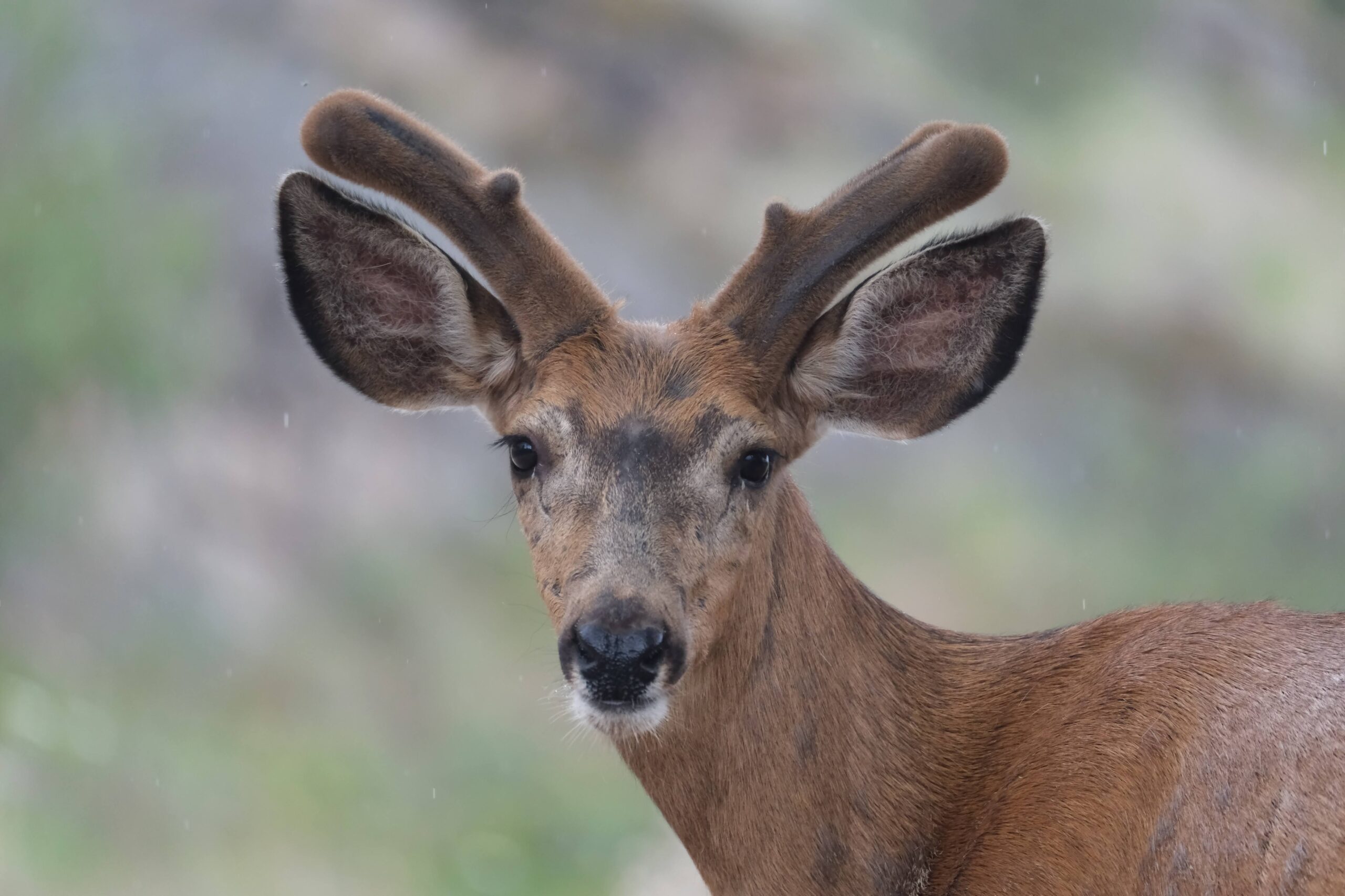
HOW IT WORKS
The SkyScout Ai system integrates multiple components that collectively can – as the company states – “Detect, respond, protect.” And there’s a lot of technology at play to make that happen.
Though the startup is at the demonstration stage, here’s how the fully integrated system will work.
Let’s take the city of Kelowna as an example. In a long-term, proactive scenario, SkyScout Ai would place multiple permanent drone docks at several locations around the city. Those weather-resistant docks would contain drones with high-resolution thermal sensors. They’re simply sitting, with the drones fully charged, waiting for a signal.
That signal could come, automatically, from satellite data. Satellites are capable of detecting thermal hotspots and lightning strikes. So, in this example, let’s say a lightning strike is detected near Kelowna. That data and GPS location is instantly relayed, via SkyScout Ai’s software, to one or more of the thermal drones. The docks open and the drones launch, headed to the area of interest.
If the drones pick up a thermal signature – a fire – that information can, in turn, be relayed immediately to First Responders. So a fire crew might be quickly dispatched. Because this early warning system can detect so quickly, that crew will have a much better chance of extinguishing a fledgling fire.
But, as we all know, fires can spread tremendously fast. And that’s where SkyScout Ai has some other options to help protect valuable assets. Those options include what the company calls “tanker drones” and a very unique product called Citrotech. It’s a food-grade fire inhibitor that can prevent ignition (and which we’ve seen in action).
If it’s still a small fire, a tanker drone carrying Citrotech could be dispatched to extinguish the fire by aerosolising that compound over the site. But don’t start thinking this has the power of a water bomber – it doesn’t (though the company envisions larger drone tankers in its future).
Rather, a drone carrying Citrotech on board has the capability to protect infrastructure at that wildfire-urban interface point. The tanker can quickly spray the roofs of multiple homes or other structures requiring protecting. The product dries quickly and crystallises. Once applied, it is nearly impossible for that protected surface to ignite – even if that roof gets coated with burning embers (a common way houses are ignited during wildfires). Citrotech could also be sprayed on dry vegetation near those structures, effectively creating a firebreak.
“Citrotech modifies the material its on at a molecular level and has extremely high efficacy when it’s dry,” explains Chief Commercial Officer and Co-Founder Shawn Bethel. “So it coats combustible vegetation and really just inhibits the ability of combustible vegetation to combust. You can’t get it to ignite.”
Bethel knows what he’s talking about when it comes to wildfires. He’s the former BC Provincial Fire Control Officer – who was responsible for all of BC’s firefighting resources out of the Provincial Wildfire Operations Centre. His bio on the SkyScout Ai website says “He brings 25+ years of operational wildland fire management experience including senior roles on incident command teams and aerial firefighting asset management. Shawn also brings an additional 15+ years working in the private sector spearheading global business operations with technology services companies providing wildfire mitigation solutions and fire aviation services.”
So Bethel obviously has deep expertise in wildfires, including all available suppression technologies.
“SkyScout Ai is pushing to protect the wildland-urban interface from new fires starting from ember transfers and lightning strikes,” he says. “When it’s applied in advance of anticipated new wildfire activity, it has time to dry – which is easy to do during drought wildfire weather conditions – and essentially stops fire in its tracks.”
Again – this is not a solution to extinguish a massive raging fire. But it definitely is capable of stopping small fires from becoming larger, and protecting homes, vineyards, orchards and critical infrastructure from igniting.
“This is not for Rank 6 conflagration fires. What this is for inception fires, combustible vegetation near homes, near assets, and for infrastructure and roadways. Citrotech is an excellent fire inhibiting product.”
Below: Shawn Bethel, followed by a DJI Agras T-40 during a SkyScout Ai demonstration. The company envisions larger “drone tankers” in its future. Scott Simmie photos
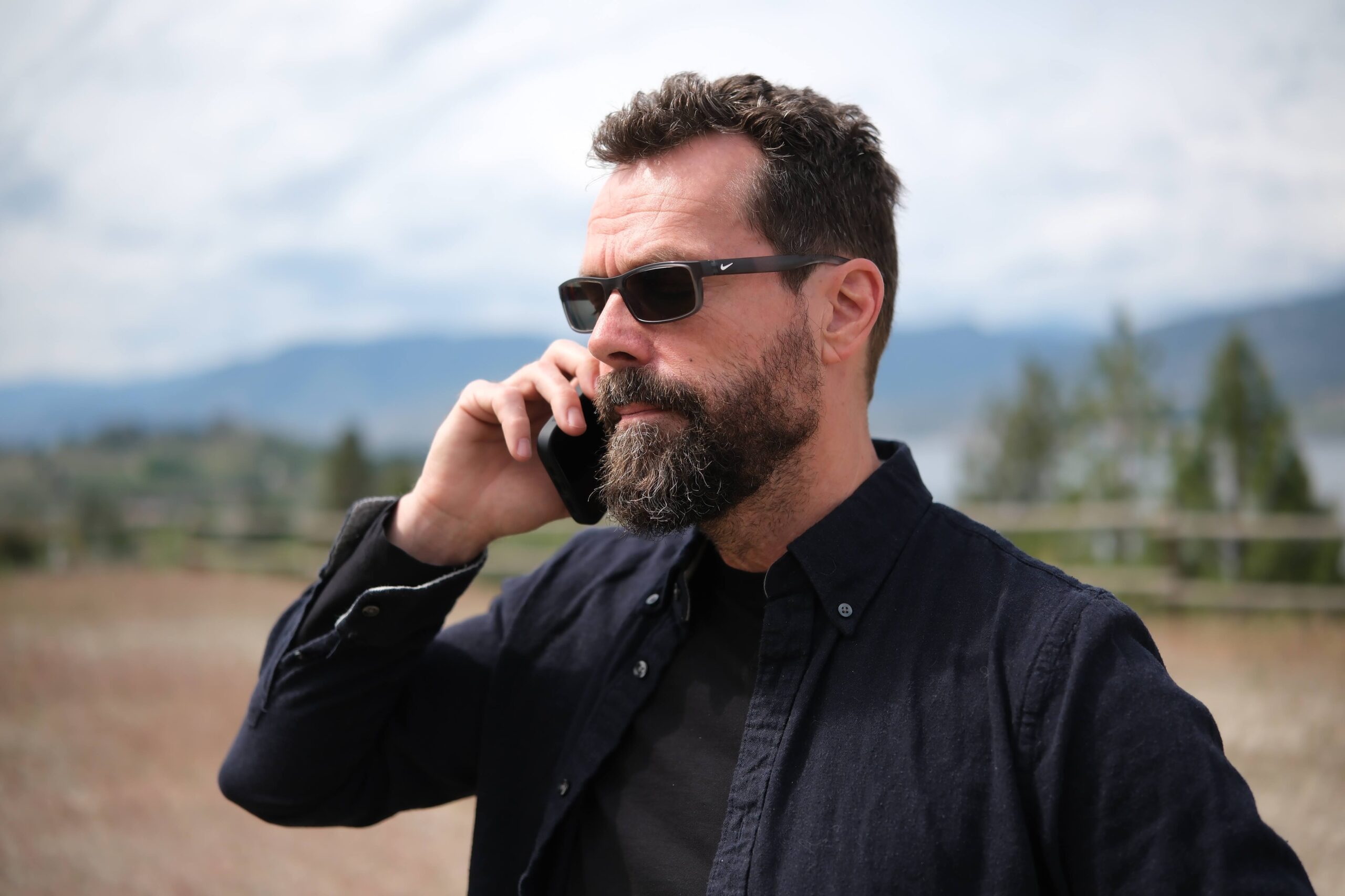
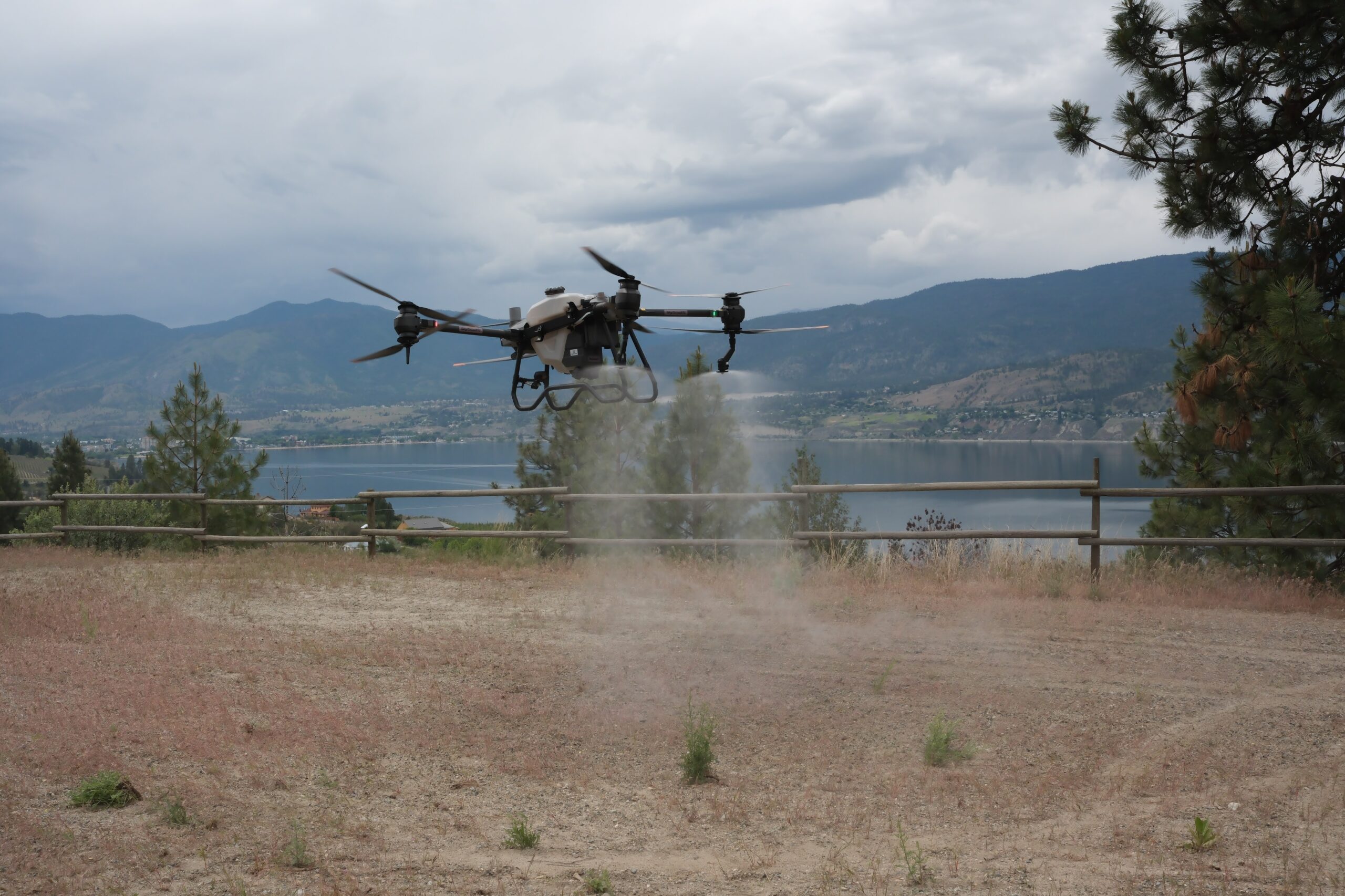
SKYSCOUT Ai IN ACTION
At the end of May, 2024, SkyScout Ai brought its mobile Command Centre to a location outside Penticton, where vineyards – also highly vulnerable to wildfire – pepper the lush hills of the Okanogan Valley. That command centre (the first of many planned) contained a dock for a thermal drone, a massive spraying drone (in this case, a DJI Agras T-40), Citrotech and a control centre for the pilot(s) who will monitor autonomous operations and manually fly the tanker drone when necessary. That Command Centre, btw, is towed on a trailer. But it has been designed to quickly detach and the entire operation can be lifted by helicopter to any location where it’s required.
SkyScout Ai came to test its technology in advance of forthcoming demonstrations for the media, First Responders and other decision makers.
During testing, a small fire was set using a small fire starter brick placed on a stone. A thermal drone with RTK positioning was dispatched to locate the hotspot. In a full demo, that data and GPS location would be automatically forwarded to First Responders or a tanker drone which would head to that spot to dispense Citrotech (which can not only inhibit, but also extinguish).
That was impressive. But there were two real show-stoppers.
In the first, a pile of dry tumbleweeds were treated with Citrotech by spraying a fine mist on them (this was done manually, but could easily be done by the tanker drone). Thirty minutes later, a pile of untreated tumbleweeds was placed directly adjacent to the treated section. Then Bethel ignited the untreated pile with a blow torch. Within seconds, flames were shooting about two metres in the air. The burn was rapidly spreading.
And when it hit the treated tumbleweed? It stopped dead. Nothing burned.
DRONE TANKER
In the second exercise, the drone tanker was filled with water. Two piles of tumbleweeds (one treated, one untreated) were again placed in a pile. The tumbleweeds were ignited and the Agras took off. From a distance of about four metres AGL, the spraying function was engaged. The blaze was extinguished in mere seconds.
So with near real-time detection using satellites and thermal drones, a tanker (or other First Responder, depending on the threat) could be dispatched literally within minutes of a lightning strike. And if that fire appeared to be growing and potentially threatening homes, vineyards, or other important infrastructure, the tanker could quickly coat these with Citrotech. Because it’s EPA-approved and food-safe, there’s no issue with spraying crops like grapes, cherries, etc. You could literally drink a glass of this stuff and be fine (though we didn’t try that).
Below: Shawn Bethel prepares to manually treat some dry brush with Citrotech
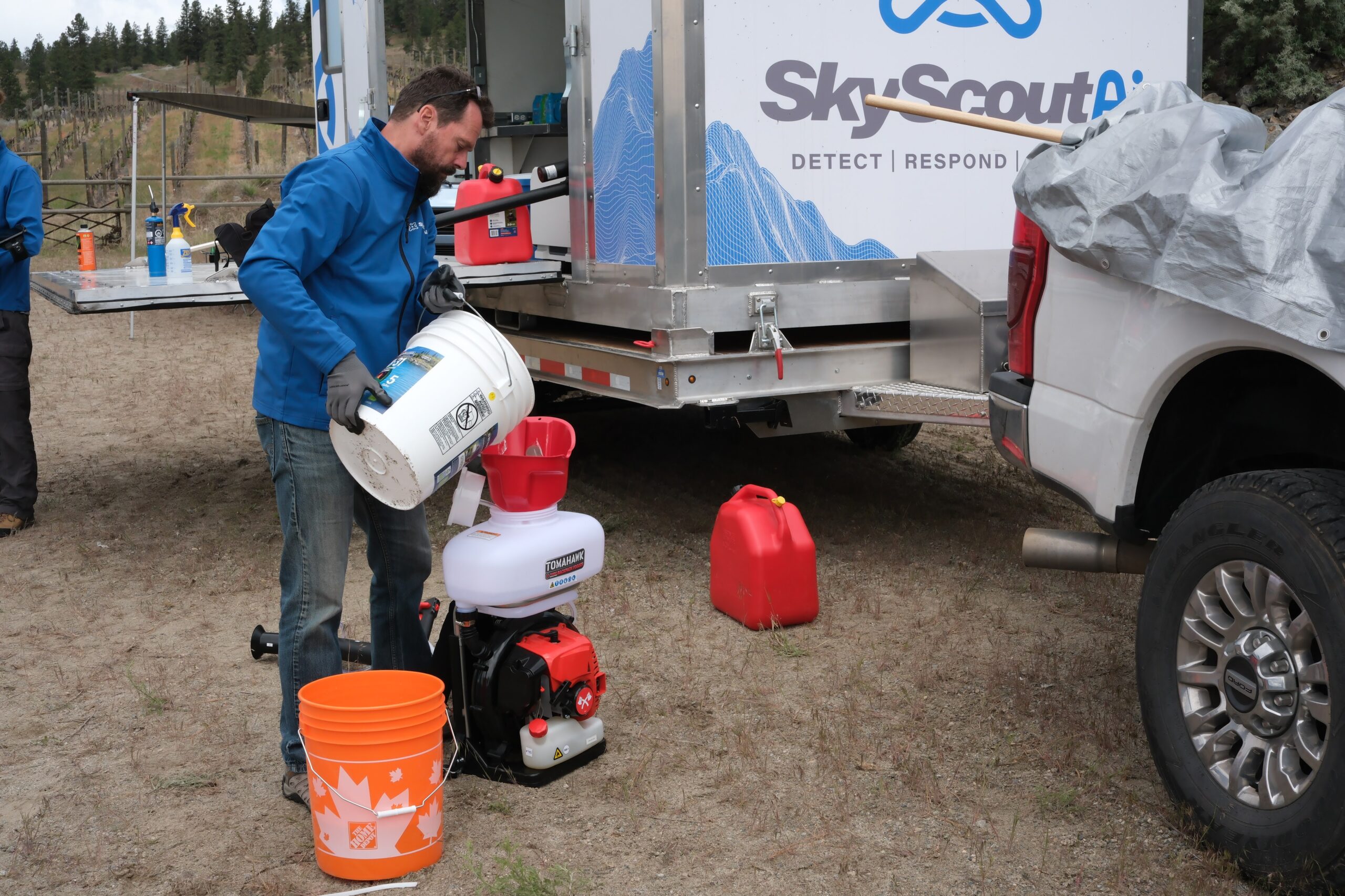
BUSINESS MODEL
Though the Citrotech is important, a key part of the value proposition is in the early detection and location of fires. The earlier a fire is detected, the better the odds of mitigation before it can get out of control.
Here, SkyScout Ai has the advantage of integrating that satellite data directly into its software – which can then trigger an immediate launch of one or multiple thermal drones. With RTK positioning, they can get a precise bead on the trouble spot – and send back not only thermal images but also high resolution photos/imagery that can be shared with First Responders. Depending on the size of the conflagration and location, a tanker drone can also be dispatched.
So the primary business model would be to have a contracts with cities adjacent to forests. The docks with thermal drones would be installed at strategic locations as the first line of defense, with a tanker drone on standby. There’s also the option, as mentioned, to lift the entire command centre by helicopter to a location where it’s urgently needed.
CITROTECH
The fire inhibitor, of course, could be dispensed by drone in the above scenario. But SkyScout Ai has an exclusive distribution contract for Citrotech’s product (known as Mighty Fire Breaker MFB-31) for all of Canada. It has plans to sell the product to individuals or companies that would like to have it handy for the ability to treat their buildings or property in advance of a threat. (Citrotech washes off in the rain, but there’s generally not much rain happening during the drought-like conditions that generally precede major wildfires. When sprayed prior to painting or staining, it remains effective.) So this product is definitely part of the equation.
“The secret sauce also is the addition of citrotech,” says Geoff Griffiths. “That fire inhibitor is the only fire inhibitor certified by the EPA in the US. It’s a non-toxic option that hasn’t existed before, and as you can see by our demonstration is highly effective.”
Griffiths says the timing for the SkyScout Ai solution is perfect.
“Obviously climate change is driving a lot of the wildfire activity that we’re seeing across the world. And regulators, government, private industry now realize that the standard ways they’ve approached wildfires in the past aren’t working or maybe aren’t good enough anymore. They’re open to new approaches. Add in the drone technology, satellite detection, and it’s a critical extra step in the evolution of a solution.”
Below: SkyScout Ai’s first Mobile Command Centre. The entire unit can be quickly detached from its trailer and transported by helicopter to remote locations. Image two: InDro’s Dr. Eric Saczuk prepares a DJI Agras T-40 for flight. Scott Simmie photos
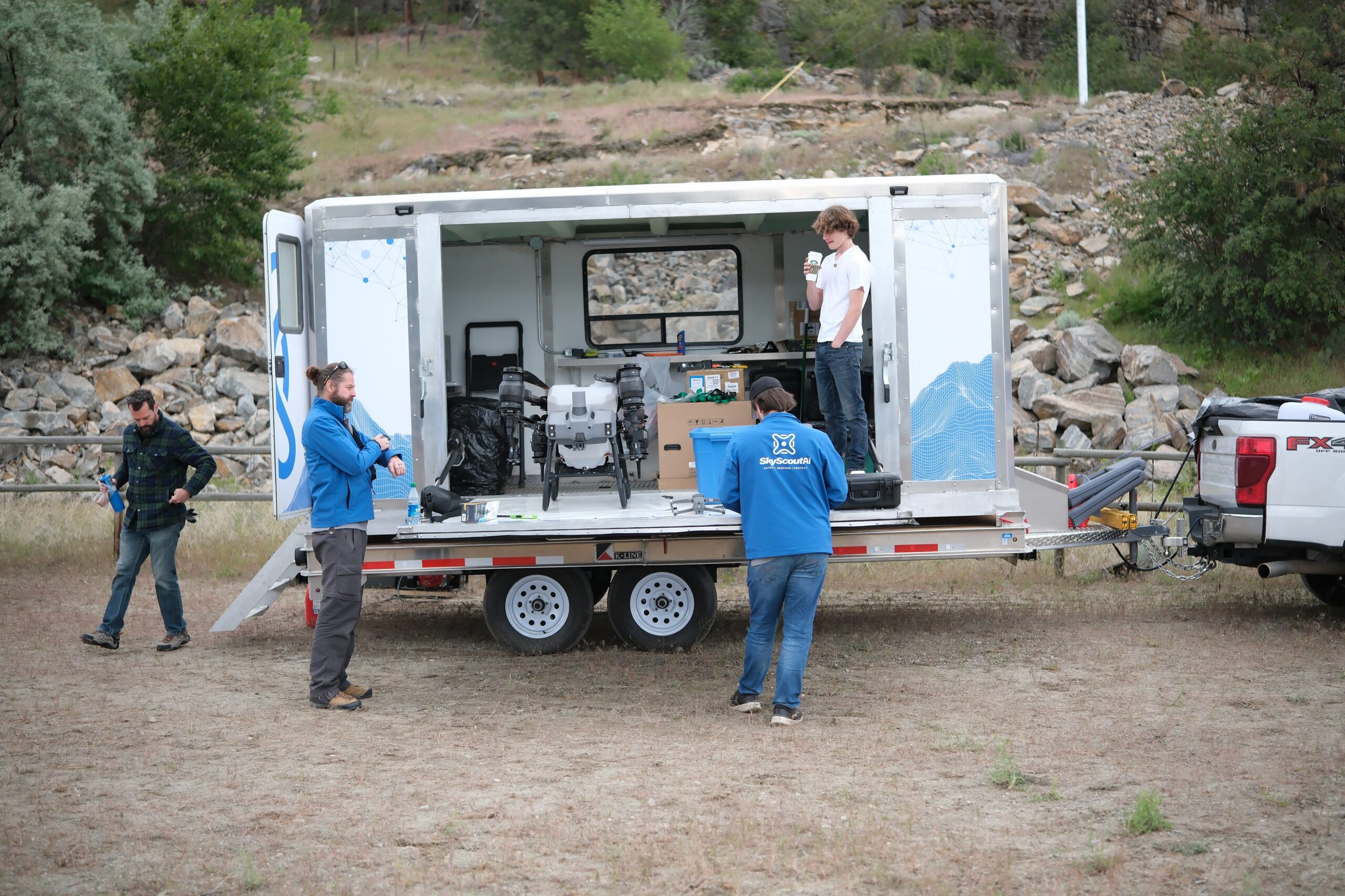
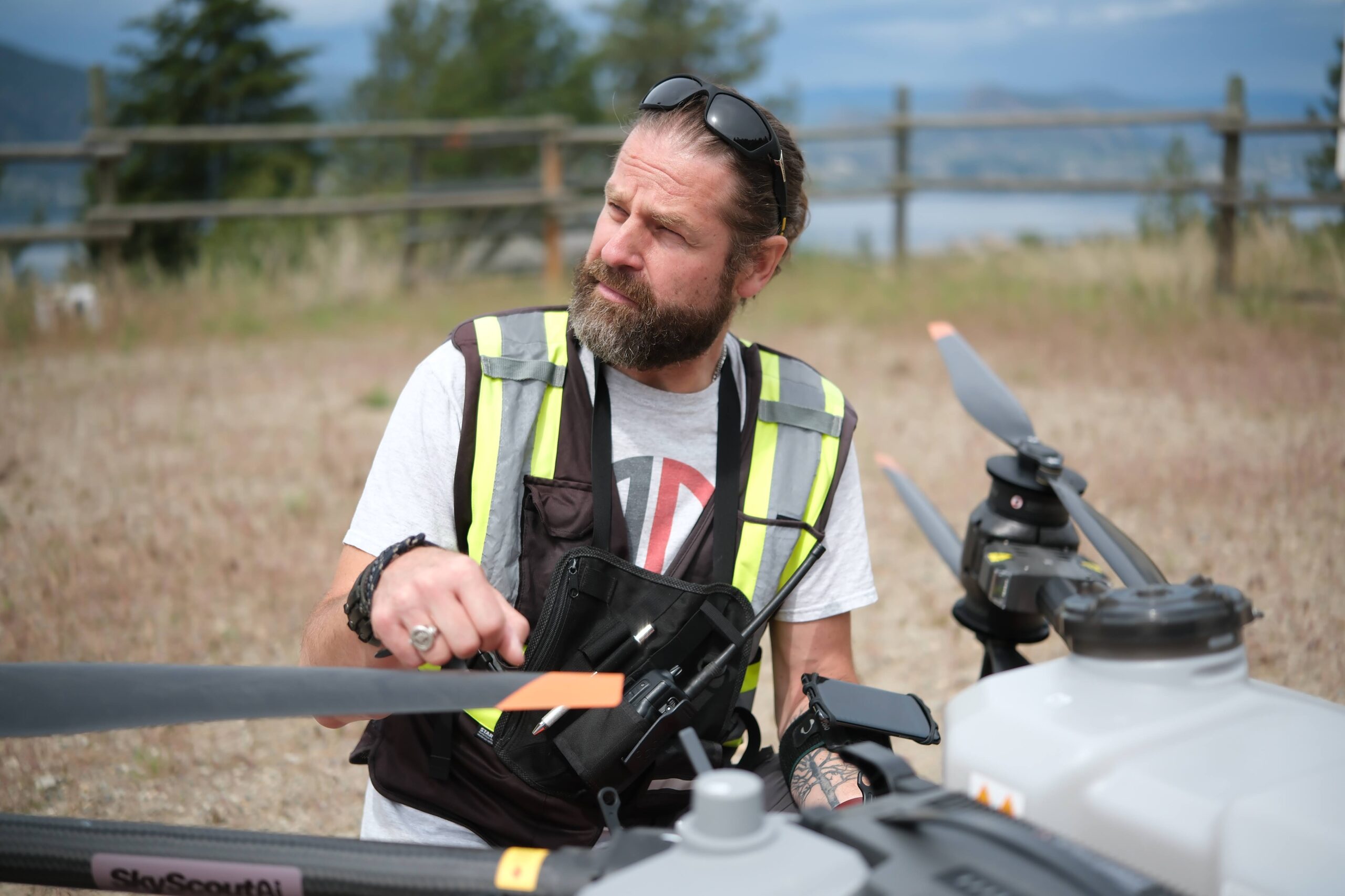
INDRO’S TAKE
We’ve been involved with wildfire operations in the past. In Kelowna last year, we were called upon to help detect hotspots indicating subterranean combustion at a landfill. Locating and extinguishing hotspots like these (or burning tree roots – which can burn for weeks and reignite new fires), are also a critical part of wildfire suppression.
When SkyScout Ai was being formed, InDro Robotics was involved.
“We’re assisting with technology on the drone side of things,” says InDro Robotics CEO Philip Reece.
“We’re providing pilots and other technical support. For example, we’re putting our InDro Command module onto the drones. This enables not only Command and Control via 5G and dense data throughput, but also the integration of all of the drone data into the SkyScout Ai dashboard. As the company grows and Transport Canada regulations change, we anticipate assisting with the R&D required for much larger tanker drones…
“Wildfires can be devastating and the models unfortunately predict will only get worse. We’re proud to be assisting with Scout Ai’s innovative solution.”
You can learn more about Scout Ai right here.

